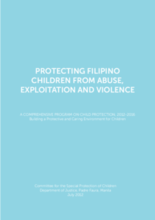Protecting Filipino Children from Abuse, Exploitation and Violence: A Comprehensive Program on Child Protection, 2012-2016 Building a Protective and Caring Environment for Children
Committee for the Special Protection of Children Department of Justice
Background and rationale
- Children’s rights to protection from any form of abuse, exploitation and violence are clearly laid out in the provisions of the Convention on the Rights of the Child (CRC) which was adopted by the UN General Assembly in November 1989 and which took effect as an international human rights treaty in September 1990. The Philippine Government ratified the CRC in July 1990. As a state party to the CRC, the Philippine Government enacted in 1992 Republic Act No. 7610, “An Act Providing Stronger Deterrence and Special Protection Against Child Abuse, Exploitation and Discrimination”, as a concrete expression of its compliance to the principles, provisions and standards of the CRC. Ten years later, in 2002, the Philippines also ratified the two optional protocols to the CRC: (a) the sale of children, child prostitution and child pornography; and (b) the involvement of children in armed conflict.
- To monitor effective enforcement of RA 7610, the Committee for the Special Protection of Children (CSPC) was created in 1995 through Executive Order No. 275. In 2011, the CSPC has been strengthened through Executive Order No. 53 issued by President Benigno Simeon Aquino III by adding key relevant government agencies and NGOs as regular members of the Committee and providing guidelines for better integration and coordination of existing child protection initiatives, with emphasis on legal and judicial protection. Headed by the Department of Justice (DOJ) and the Department of Social Welfare and Development (DSWD), the Committee is tasked to initiate and coordinate the preparation of a Comprehensive Program on Child Protection (CPCP). Two CPCP documents had already been prepared by the Committee for two programming cycles, namely, CPCP 1, 2001-2005 and CPCP 2, 2006-2010. Both CPCP 1 and 2 were not viewed as stand-alone program documents but as components of the National Plans of Action for Children (NPAC) for the corresponding periods. CPCP 2 implementation was extended to 2011 in order to synchronize it with the NPAC planning cycle.
- While data remain inadequate, there have been increasing numbers of Filipino children who are vulnerable to and have become victims of various forms of abuse, exploitation and violence as seen in reports of both government agencies and non-government organizations (NGOs). The UN Committee on the Rights of the Child (UN-CRC) based in Geneva also underscored the growing complexity of child protection issues and challenges in the Philippines through its 2005 and 2009 Concluding Observations on the Philippine Government Introduction THIRD COMPREHENSIVE PROGRAM ON CHILD PROTECTION, 2012-2016 7 report on CRC implementation. The CPCP therefore needs to be reviewed and updated periodically to ensure its relevance and responsiveness in addressing these issues. But the greater challenge lies in the effective implementation of the CPCP, both at national, sub-national and local levels – particularly at the level of local government units (LGUs) and local communities where preventive actions and early interventions against any form of child abuse, violence and exploitation are critical.
- A quick review of the CPCP, 2006-2010 was conducted between July to August 2011 using participatory and qualitative methods such as focus group discussions (FGD), key informant interviews (KII), and document reviews (DR). The results of the quick review were further validated through regional and island-wide consultations with major duty bearers and stakeholders involved in the field of child protection organized by the Committee for the Special Protection of Children (CSPC). The assessment results are presented in Chapter 3 of this document. The findings guided the revision and update of the CPCP for the period 2012-2016.
- Building on experiences and key lessons learned from the implementation of the two previous CPCP (CPCP 1, 2001-2005 and CPCP 2, 2006-2010/11), the third CPCP covering the period 2012-2016 will emphasize the need for building and strengthening structures and systems for child protection at national, subnational and local levels particularly the local councils for the protection of children. There will be a stronger emphasis on institutional capacity building – in terms of the social welfare system as well as the legal and judicial system – rather than just building individual capacities. The focus of CPCP 2 on an integrated child protection program, as opposed to issue-based responses and interventions, will be intensified during CPCP 3 in order to address the underlying and structural factors that bring about child abuse, exploitation and violence. The integrated child protection program will be pursued under the framework of creating a protective and caring environment for children (PCEC). The key elements of a protective and caring environment for children are described in Chapter 4.

